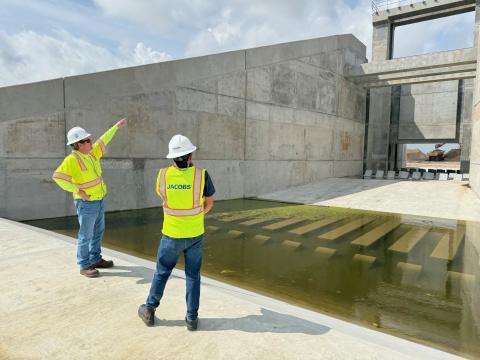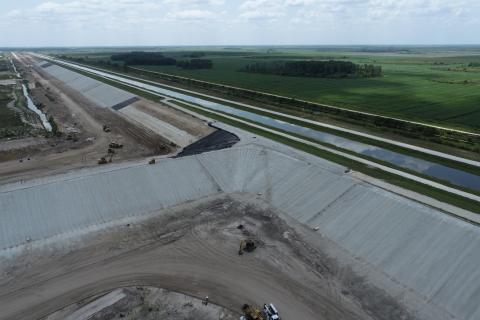Climate change continues to alter historic weather patterns—some areas of the U.S. like the Southwest are getting drier while many other parts of the country including Florida are getting wetter. But that added water is not just an issue for residents and visitors to the Sunshine State. It also has a negative impact on the ecosystem, especially in sensitive locations like estuaries that rely on a delicate balance between fresh water and brackish water.
To help make the Florida ecosystem more resilient, Jacobs is managing construction of a 10,500-acre aboveground reservoir near the Caloosahatchee River in Hendry County, Fla as part of a joint venture with Tetra Tech known as J-Tech. When complete, the reservoir will store excess freshwater from the local watershed and Lake Okeechobee, help sustain a healthy nursery for fish in the Caloosahatchee Estuary and enhance the resiliency of water resources in southwest Florida.
The South Florida Water Management District’s C-43 West Basin Storage Reservoir Project was designed to capture water from Lake Okeechobee and excess C-43 basin runoff during Florida’s wet season (May through October). Water stored in the reservoir will be released during Florida’s dry season (November through April) to revitalize fish and oyster habitats along the Caloosahatchee Estuary. Part of the Comprehensive Everglades Restoration Plan enacted by Congress in 2000 and funded by the U.S. Army Corps of Engineers, the project combines both environmental stewardship along with water storage. Once complete, the reservoir will have a total storage capacity of more than 55 billion gallons of water.
Delivering a resilient solution…
Extending from Lake Okeechobee to the Gulf Coast, the Caloosahatchee River is approximately 75 miles long and forms the backbone of the biologically rich and diverse Caloosahatchee Estuary. Estuaries are critically important part of the ecosystem, providing a safe area for small fish, shellfish, migrating birds and shore animals. Estuaries rely on a delicate balance of salinity and are vulnerable to disruptions in water quality and to algal blooms, which can produce toxic or harmful effects on both wildlife and people.
As part of the C-43 West Basin Storage Reservoir Project, we conducted a water quality feasibility study to examine conventional and innovative biological, physical and chemical technologies to treat water entering and discharging from the reservoir or to reduce potential algal biomass within the reservoir.
Our recommendations included in-reservoir treatment with alum to help prevent algal blooms in the reservoir itself as well as a post-storage water quality component to treat reservoir discharges that can be monitored prior to being returned to the Caloosahatchee River and Estuary.
“Construction projects of this scale and schedule come with their own set of unique challenges,” says Jacobs Program Manager Shawn Waldeck. “But because we’re also working to protect animals like the Florida panther and other endangered or threatened species, it adds an additional element of complexity.”
To ensure that wildlife are protected during construction, the program employs a full-time wildlife biologist who coordinates with the Florida Fish and Wildlife Conservation Commission and the U.S. Fish and Wildlife Service to track eight endangered Florida panthers who frequent the area.
“As a Florida native myself, I feel like I'm making an impact on the welfare of Florida wildlife," says Jacobs Biologist Ashley Kelley. "It’s very rewarding to know that I can be a part of something bigger, right in my own backyard."
…for a more connected, sustainable tomorrow
Jacobs’ proven history of delivering complex construction projects coupled with its stewardship of the environment are key reasons why the SFWMD chose J-Tech for the C‑43 West Basin Storage Reservoir Project. The project has become a springboard for an even larger reservoir project, the Lake Okeechobee Component A Storage Reservoir project (known as LOCAR).
Jacobs and Tetra Tech recently completed a feasibility study and environmental impact statement for LOCAR to explore opportunities for reservoir storage north of Lake Okeechobee. The proposed reservoir will be even larger than the C-43 reservoir, covering an area of more than 12,000 acres and having a storage capacity of more than 65 billion gallons. As with the C-43 reservoir, LOCAR will provide ecological benefits to the lake and its northern estuaries.
“We’ve been a proud partner with the South Florida Water Management District for over 20 years,” adds Shawn. “And we’re excited to continue that partnership as we work together to restore Florida’s unique ecosystems and important natural resources.”
Did you know?
-
16
miles around the perimeter of the reservoir
-
25
maximum depth of water in feet in the basin depending on time of year and need (in contrast, Lake Okeechobee averages only about 10 feet deep)
-
1 K
rate of water in million gallons per day that will eventually be pumped into the Caloosahatchee Reservoir using four massive pumps
-
10.5 K
approximate number of acres of project area (a former citrus grove)
-
20 M
cubic yards of sand excavated onsite used for the reservoir foundation
-
55 B
gallons of water stored in the reservoir once complete (enough to cover Manhattan in 12 feet of water)



















































